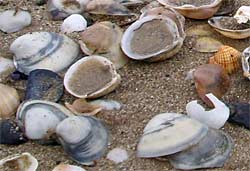To a first approximation, all startups fail. This should never be a deterrent to starting one up.
– I wish I could attribute this to some famous name, but hey, it’s all mine… and very true.
As I mentioned before, these days I’m writing a white paper I call “Solutions to Information Overload: a Catalogue Raisonné”, being an encyclopedic compilation of every solution I know to Information Overload. Many of these are products from small startup companies, and I’m repeatedly delighted by the originality of thought and the positive energy characterizing these.
Less delightful by far is the observation that many of these startups disappear, leaving varying traces behind them. This complicates my research, and raises some interesting thoughts.
Empty shells in the sand

Startups are foci of incredible energy, and while we’re on a physics metaphor, we can say that they’re like those virtual particles that pop in and out of the universal vacuum in quantum mechanics. They appear out of nowhere (a garage is, from a corporate viewpoint, close to nowhere) and they either survive or flick out of existence in a variety of processes. This can be either because they run out of money and luck, or because they’re acquired by large companies, or – rarely – because they become large companies themselves. Being acquired is considered the holy grail by many, but personally I prefer the third option: I’ve seen too many innovative companies bought with the express intent of silencing them and burying their product. Not that becoming large is risk-free… it is all too easy to lose your soul on the way.
Here I want to discuss what happens to the startups that really fail to make it in their early phase. In one sense, their remains line the virtual beaches of the internet, like washed-up sea shells. In another, they become the seeds of future companies. But at this point I really have to stop mixing metaphors…
Sorting the living from the dead
The problem I have as I try to catalog all those Information Overload products is that many pointers I have link to seemingly live sites of what turn out to be dead companies. This is because online assets are so inexpensive – even free – that once you set up a web site, you can disappear and the site will stay accessible for years, until some new web standard breaks it. And since these sites were developed to advertise a product, they’re full of pep and optimism, seeming as alive as can be. There are telltale signs, but you need to hunt them down…
The easiest way to verify a company’s existence is to check its blog, a standard fixture linked from its home page. If the latest blog post is from 2011, you can be pretty sure you’re looking at a beautiful but lifeless hulk. Then I run a Google search on the company name, checking the dates – or an advanced search focused on the past year. Finally I head for LinkedIn and check the founders: if the startup isn’t listed as their current job, you can be pretty certain. In ambiguous cases I actually write to the founder to get more insight.
The problem is that many startups act like political parties: once these lose an election, they may leave their web site frozen in the full glory of the hopeful day before. These startups don’t even bother to bring the site down, or to make one last post: “We’re sorry, but we’re closing down / changing direction / being bought by…”
The cycle of life
So what should we learn from these dead startups? No, not to avoid the entrepreneurial path in life. As I said in the quote above, which I often throw at startup people coming in for advice, failure is part of the startup reality – and that’s perfectly OK. This is not merely an attempt at optimism; it’s an empirical observation. Founders of startups that fail simply go on to create a new startup, applying their skills, innovation and enthusiasm, and throwing in what they’ve learned in the previous attempt. And if this one fails they start a third one… it’s a huge effort, but they usually have what it takes, or they would be working a 9 to 5 job in the first place. So dead startups serve as the seeds of new ones. Innovation always moves on!
As for the dead websites they leave littering the web… I wish they’d have the presence of mind to do the right thing and wrap things up, sharing with the rest of us what happened, where they’re heading, and what we can learn from it. But they should definitely keep the blog up and available: there’s so much wisdom in a blog’s archives, and it’s all searchable by Google. Let us have that as a parting gift…
Image credit: Wikimedia Commons


It probably pains a lot of founders to go back to those startup’s blogs to post a goodbye message. Failure, or even a long goodbye, can be a bit embarrassing. But it’s in everyone’s interest to see those messages posted. Professionally, it gives people a way to find your next step if they’ve lost touch. Business wise, former users can be warned there’s nobody home.
Startups are a volatile business, but we don’t need to make it any worse by not leaving any signposts along the way. As for those blogs, I completely agree. Leave them up so we can enjoy the knowledge they contain!
Interesting concept: http://closedclub.co/ keeps track of defunct startup products.
The original closedclub.co seems to be no more nowadays. An example of a snake eating itself to oblivion?
Your piece reminds me of the wish to have a database of failed attempts to solve a big problem. Such a database could be consulted by people who wish to approach the problem from a fresh viewpoint.
Examples of problems for which there are several failed attempts:
1. Failure to build a working perpetuum mobile.
2. Failure to convert lead into gold (before development of particle accelerators).
3. Videophones (before advent of ADSL and the like).
4. Automatic speech recognition (before Deep Learning).
I would keep Perpetuum mobile out of this list… being theoretically impossible, it involves a different kind of people attempting to “solve” it.
More examples:
5. Failed attempts to reach the North and South poles.
6. Failed attempts to climb mountains like the Matterhorn and Everest.